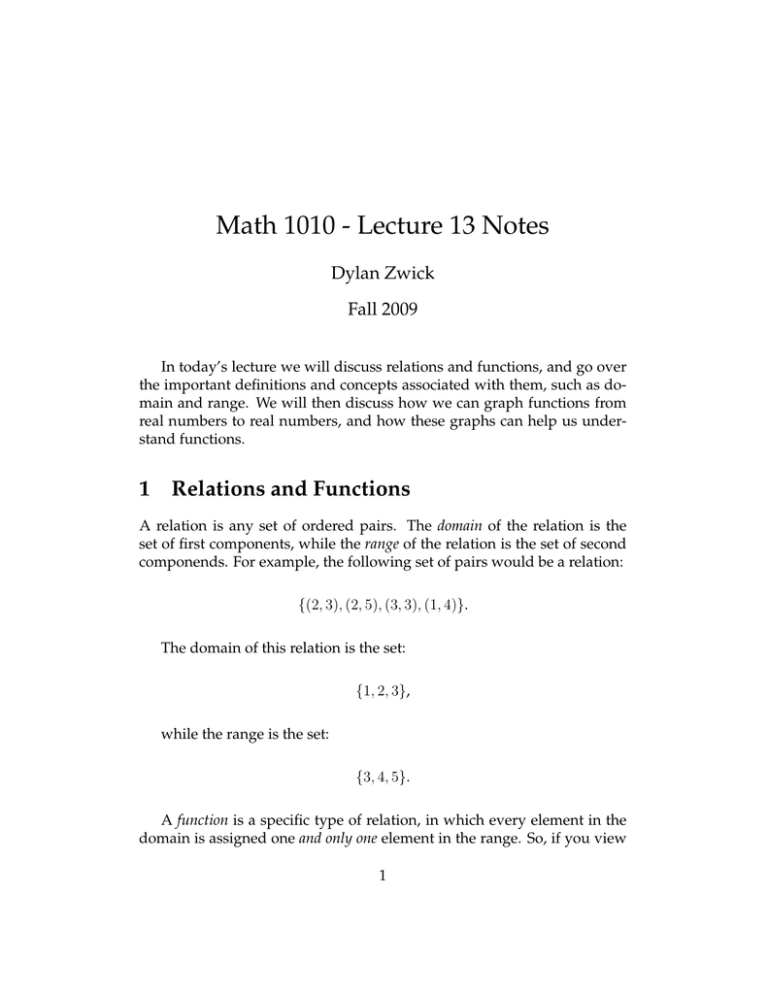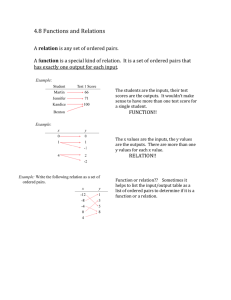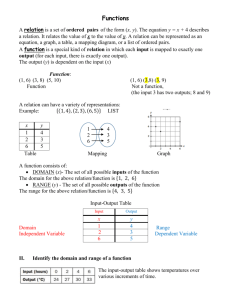Math 1010 - Lecture 13 Notes Dylan Zwick Fall 2009
advertisement

Math 1010 - Lecture 13 Notes
Dylan Zwick
Fall 2009
In today’s lecture we will discuss relations and functions, and go over
the important definitions and concepts associated with them, such as domain and range. We will then discuss how we can graph functions from
real numbers to real numbers, and how these graphs can help us understand functions.
1 Relations and Functions
A relation is any set of ordered pairs. The domain of the relation is the
set of first components, while the range of the relation is the set of second
componends. For example, the following set of pairs would be a relation:
{(2, 3), (2, 5), (3, 3), (1, 4)}.
The domain of this relation is the set:
{1, 2, 3},
while the range is the set:
{3, 4, 5}.
A function is a specific type of relation, in which every element in the
domain is assigned one and only one element in the range. So, if you view
1
the domain as the set of possible inputs, and the range as the set of possible
outputs, a function is a relation in which every input has only one output.
Note that we could have many inputs going to the same output, but we
can’t have many outputs going to the same input.
Examples
1. Would the relation that takes a person and outputs the person’s maternal grandmother be a function?
2. Would the relation that takes a person and outputs the person’s siblings (if any) be a function?
3. Would the relation that takes a real number and squares it be a function?
4. Would the relation that takes a real number and finds its square root
be a function?
2
Now, when we have a discrete (finite) set of inputs and a discrete set
of outputs we can frequently represent a relation or a function as just a
list of ordered pairs. However, when we’ve got larger domains (such as
all real numbers) a list of ordered pairs becomes unreasonable, or even
impossible. In these cases we frequently use an equation to represent a
relation of function. For example, the equation:
y = x2
could be viewed as a function. It takes a set of inputs (x-values) and
for any given input it gives us a specific output (y-value). So, for example,
if we input x = 3 into this equation, we’d get an output y = 32 = 9. In an
equation we call the input variable the independent variable, and the output
variable the dependent variable. In the above eqution x is the independent
variable, while y is the dependent variable.
When we have an equation representing a function, it’s commonly convenient to give our function a name so that it can be easily referenced.
Frequently, we call the function “f ”, and write our equation:
f (x) = x2 + 1
for example. What this means is that our domain is the possible xvalues, the inputs, and for each input x our f takes that input and calculates f (x), the output. We read f (x) as the value of f at x, or as simply f
of x.
If we want to take a particular input, say x = 3, and calculate the corresponding particular output we write:
f (3) = 32 + 1 = 10.
This means that for an input of 3 our output f (3) is 10.
3
Examples
For the eqution g(x) = x2 + 3 calculate:
1. g(3).
2. g(−2).
3. g(x + 1).
Finally, if we’re just given an equation, we take the domain to be all
real numbers for which the equation makes sense. In other words, all real
numbers where the equation is defined. For example, the equation:
f (x) =
x−3
x+1
has a domain of all real numbers except x = −1. This is because our
function is defined for all real numbers except x = −1. At x = −1 we have
division by zero, which does not make sense and is undefined.
4
2. f (x) = 2x − 1.
3. f (x) = |x|.
4. f (x) = x2 .
5. f (x) = x3 .
6
Examples
Graph the following functions:
1. f (x) = x2 − 3.
2. f (x) = |x − 3|.
Finally, we can reflect a graph around either the x or y axis through the
following transformations:
• Reflection around the x-axis corresponds to f (x) → −f (x).
• Reflection around the y-axis corresponds to f (x) → f (−x).
8
Example
1. Graph the function f (x) = −x2 .
9











